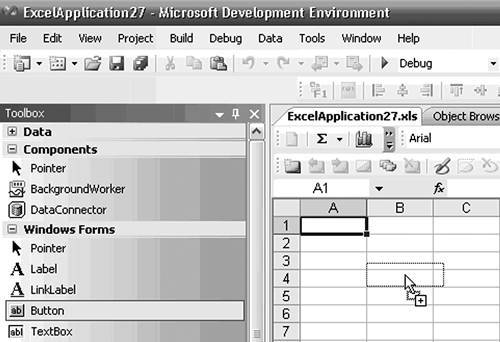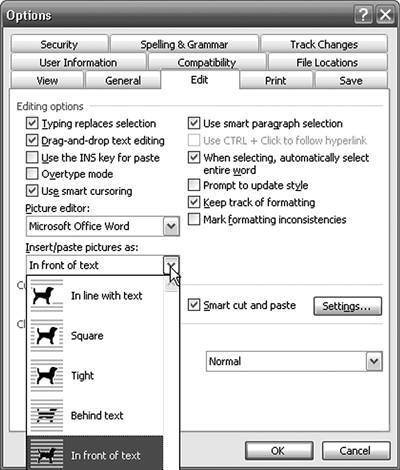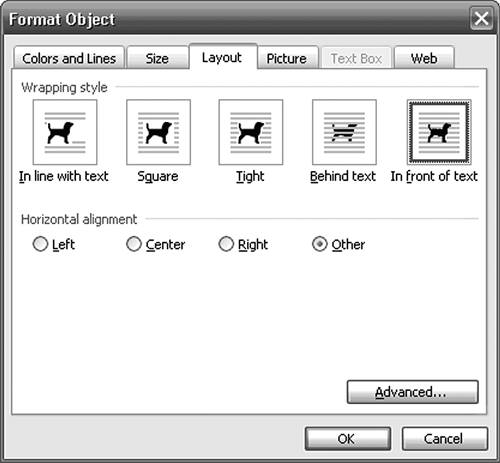Adding Windows Forms Controls to Your Document
One of the key design goals for VSTO was to keep the design experience as close to existing Windows Forms development as possible, and adding Windows Forms controls to the document is a key tenet of this goal. The great thing about adding controls to the document or spreadsheet is that you really do not have to think about it because most of the design experience is almost identical to that of creating a Windows Forms form. However, there are some differences in the experience that we examine in this section.
When you create a new project based on an Excel workbook or Word document, VSTO creates a project and automatically loads the Excel or Word document surface into Visual Studio to provide a design surface for you to drag and drop controls onto. In the C# profile, the toolbox is set to auto hide by default. It is easier to pin the toolbox to make it dock to the side of Visual Studio window because it is difficult to drag and drop from the toolbox onto Word or Excel when it is in its default auto hide mode. Why? When the toolbox shows itself, it obscures quite a bit of the left side of the document or spreadsheet. When you drag and drop a control onto the document surface, the toolbox does not auto hide and get out of the way until the drag and drop is over.
Modes for Adding Controls
VSTO provides three modes for adding controls to the document surface:
- Drag and drop This involves selecting the control from the toolbox and dragging it onto the document or worksheet. This method creates a default-sized control on the document and proves particularly useful for adding controls such as a button that tend to be a set size. Figure 14-5 shows this mode.
Figure 14-5. Drag and drop of a Button control from the toolbox to an Excel worksheet.

- Drawing Clicking a control in the toolbox to select it and then moving your mouse pointer over the document or spreadsheet changes the cursor to the standard draw cursor. In this mode, you can click and drag a rectangle, thereby drawing the control onto the document or spreadsheet. Figure 14-6 shows this mode.
Figure 14-6. Drawing a PictureBox control on a Word document.

- Double-click Double-clicking a control in the toolbox causes a control to be added at the current insertion point in the document or spreadsheet. The insertion point in Word behaves quite differently from Excel, not surprising given the flow-based nature of a document compared to the grid of a spreadsheet. Double-clicking a control in the toolbox in a Word VSTO project inserts the control at the cursor in the document. Double-clicking a control in the toolbox in an Excel VSTO project inserts the control at the center of the spreadsheet.
Controls That Are Not in the Control Toolbox
A number of Windows Forms controls do not show up in the controls toolbox for Excel and Word projects. These controls were purposely excluded because of known issues in using them on the document surface. Some of these issues are purely design-time related in that the design-time representation of the control does not work well. This does not mean that the control cannot be used, but it might mean that the only way that you can use it on a document is by adding it programmatically at runtime or by using the control in a user control that you then add to the document.
A good example of such a control is the group box. The design-time experience of the group box does not work well in Excel or Word because the group box designer requires the container to support container drag and drop, which the Excel and Word designer does not support. You have two options to work around this limitation:
- Create the group box programmatically at runtime. This approach uses VSTO's support for adding controls at runtime that is described later in this chapter.
- Create a custom user control that contains the group box and the contained controls within the group box. After this is built, drag the user control onto the document or spreadsheet as you would any control. The advantage to this approach is that you get full-fidelity designer support in the user control designer, making it easy to layout the controls.
Some other controls are excluded from the toolbox because of the following reasons.
- The control does not work with the VSTO control hosting architecture. For example, the DataNavigator control relies on a container model that is not supported in the VSTO control hosting architecture in order to communicate with other data components.
- The control relies heavily on being hosted in a Windows Forms form. For example, the MenuStrip control cannot be added to a document or spreadsheet, only to a form.
- The control has problems at design time. Because many controls were designed prior to the release of VSTO, some have bugs when hosted on a document or spreadsheet surface in the designer. For example, the Rich Edit control has considerable issues when running inside of Excel and Word at design time. In the interest of stability, it was removed from the controls toolbox, but you can add it to a document or spreadsheet programmatically at runtime.
Control Insertion Behavior in Word
A control added to Word is affected by the insertion settings set in Word's Options dialog. A control can be inserted "in line with text," which means the control is inserted into the text flow of the document and moves as the text flow changes. It can also be inserted "in front of text," which means that the control is positioned at an absolute position in the document that does not change when the text flow changes.
The default insertion behavior in Word can be changed to be exact-position based rather than flow based by changing the insert/paste pictures setting in Word's Option dialog from the default In line with text to In front of text. After you change this setting, all controls will be positioned where you want them instead of having to be in line with the text. To change this setting, choose Options from the Tools menu and click the Edit tab of the Options dialog. Figure 14-7 shows the Insert/paste pictures setting.
Figure 14-7. Changing the default insertion behavior in Word's Options dialog.

You can also change the way a control in Word is wrapped with the text by right-clicking the control in the designer and selecting the Format Control menu option. Doing so brings up Word's Format Object dialog shown in Figure 14-8. Changing the wrapping style from in line with text to in front of text provides exact positioning.
Figure 14-8. Changing the wrapping style for a control with Word's Format Object dialog.

From the standpoint of the Word object model, a control whose wrapping style is set to In line with text, Square, or Tight is represented by the InlineShape object in Word's object model and found in the Document object's InlineShapes collection. A control whose wrapping style is set to Behind text or In front of text is represented by the Shape object in Word's object model and found in the Document object's Shapes collection.
Control Insertion Behavior in Excel
Excel also provides options for positioning a control on the worksheet surface, with the default being to move the control relative to the cell but not to size with the cell. This setting means that when you put a control onto the worksheet surface, it is linked to the cell that you dropped it on; so if you insert or delete cells around that cell, the control will stay positioned relative to the cell it was dropped on. However, if you resize the cell you dropped, the size of the control stays the same. This is usually the behavior that you would expect when adding a control. If you want your control to resize with the cell, you can either draw the control over the cell so that it exactly matches the size of the cell (not for the faint of heart) or right-click the control inside of Visual Studio and select Format Control, which brings up the Format Control dialog shown in Figure 14-9. Click the Properties tab and select one of three options:
- Move and size with cells This option ensures that the control resizes and repositions relative to the cell resize. For example, if your control takes up half of the cell, it will continue to take up half of the cell when the cell is resized
- Move but do not size with cells This is the default setting, which ensures that the control remains with the cell it was dropped on but does not resize.
- Do not move or size with cells This setting provides you with exact positioning that does not change when the cell the control that was dropped on is moved or resized.
Figure 14-9. Setting object positioning options for a control in Excel.

Layout of Controls on the Document or Worksheet Surface
The Windows Forms editor in Visual Studio has some great alignment tools that make it much simpler to design professional-looking forms without having to resort to per-pixel tweaks on each control. Unfortunately, the alignment tools do not work on documents because the display surface is very different from a form. In the place of these tools, a new toolbar provides easy access to the alignment functionality in Word and Excel. Figure 14-10 shows the toolbar. To align controls, just select the controls you want to align, and then click the button that represents the alignment option you want.
Figure 14-10. The control positioning toolbar in VSTO.

Part One. An Introduction to VSTO
An Introduction to Office Programming
- Why Office Programming?
- Office Object Models
- Properties, Methods, and Events
- The Office Primary Interop Assemblies (PIAs)
- Conclusion
Introduction to Office Solutions
- The Three Basic Patterns of Office Solutions
- Office Automation Executables
- Office Add-Ins
- Code Behind a Document
- Conclusion
Part Two. Office Programming in .NET
Programming Excel
- Ways to Customize Excel
- Programming User-Defined Functions
- Introduction to the Excel Object Model
- Conclusion
Working with Excel Events
Working with Excel Objects
- Working with Excel Objects
- Working with the Application Object
- Working with the Workbooks Collection
- Working with the Workbook Object
- Working with the Worksheets, Charts, and Sheets Collections
- Working with Document Properties
- Working with the Windows Collections
- Working with the Window Object
- Working with the Names Collection and Name Object
- Working with the Worksheet Object
- Working with the Range Object
- Special Excel Issues
- Conclusion
Programming Word
Working with Word Events
Working with Word Objects
- Working with Word Objects
- Working with the Application Object
- Working with the Dialog Object
- Working with Windows
- Working with Templates
- Working with Documents
- Working with a Document
- Working with the Range Object
- Working with Bookmarks
- Working with Tables
- Conclusion
Programming Outlook
- Ways to Customize Outlook
- Introduction to the Outlook Object Model
- Introduction to the Collaboration Data Objects
- Conclusion
Working with Outlook Events
Working with Outlook Objects
- Working with Outlook Objects
- Working with the Application Object
- Working with the Explorers and Inspectors Collections
- Working with the Explorer Object
- Working with the Inspector Object
- Working with the NameSpace Object
- Working with the MAPIFolder Object
- Working with the Items Collection
- Properties and Methods Common to Outlook Items
- Outlook Issues
- Conclusion
Introduction to InfoPath
- What Is InfoPath?
- Getting Started
- Form Security
- Programming InfoPath
- Data Source Events
- Form Events, Properties, and Methods
- Conclusion
Part Three. Office Programming in VSTO
The VSTO Programming Model
- The VSTO Programming Model
- VSTO Extensions to Word and Excel Objects
- Dynamic Controls
- Advanced Topic: Dynamic Host Items
- Advanced Topic: Inspecting the Generated Code
- VSTO Extensions to the Word and Excel Object Models
- Conclusion
Using Windows Forms in VSTO
- Using Windows Forms in VSTO
- Introduction
- Adding Windows Forms Controls to Your Document
- Writing Code Behind a Control
- The Windows Forms Control Hosting Architecture
- Properties Merged from OLEObject or OLEControl
- Adding Controls at Runtime
- Conclusion
Working with Actions Pane
Working with Smart Tags in VSTO
- Introduction to Smart Tags
- Creating Document-Level Smart Tags with VSTO
- Creating Application-Level Smart Tags
- Conclusion
VSTO Data Programming
- VSTO Data Programming
- Creating a Data-Bound Customized Spreadsheet with VSTO
- Creating a Data-Bound Customized Word Document with VSTO
- Datasets, Adapters, and Sources
- Another Technique for Creating Data-Bound Spreadsheets
- Caching Data in the Data Island
- Advanced ADO.NET Data Binding: Looking Behind the Scenes
- Binding-Related Extensions to Host Items and Host Controls
- Conclusion
Server Data Scenarios
- Populating a Document with Data on the Server
- Using ServerDocument and ASP.NET
- A Handy Client-Side ServerDocument Utility
- The ServerDocument Object Model
- Conclusion
.NET Code Security
- .NET Code Security
- Code Access Security Versus Role-Based Security
- Code Access Security in .NET
- Location, Location, Location
- Strong Names
- Publisher Certificates
- Trusting the Document
- Deploying Policy to User Machines
- Conclusion
Deployment
- Deployment
- VSTO Prerequisites
- Deploying to an Intranet Shared Directory or Web Site
- Local Machine Deployment Without a Deployment Manifest
- Editing Manifests
- Creating Setup Packages
- Advanced Topic: Deploying Network Solutions to Be Cached Locally
- Conclusion
Part Four. Advanced Office Programming
Working with XML in Excel
- Introduction to Excels XML Features
- Introduction to XML Schema Creation in Visual Studio
- An End-to-End Scenario
- Advanced XML Features in Excel
- Excel-Friendly XML Schemas
- VSTO Support for Excel Schema Mapping
- Conclusion
Working with XML in Word
- Introduction to Words XML Features
- An End-to-End Scenario: Creating a Schema and Mapping It into a Word Document
- Exporting the Mapped XML in the Document to an XML Data File
- Importing an XML Data File into the Mapped Document
- The XML Options Dialog
- VSTO Support for Word Schema Mapping
- VSTO Support for the WordML File Format
- Conclusion
Developing COM Add-Ins for Word and Excel
- Introduction to Add-Ins
- Scenarios for Using Add-Ins
- How a COM Add-In Is Registered
- Implementing IDTExtensibility2
- Writing a COM Add-In Using Visual Studio
- The Pitfalls of MsCoree.dll
- COM Interop and Regasm.exe
- Shimming: A Solution to the Problems with MsCoree.dll
- Conclusion
Creating Outlook Add-Ins with VSTO
EAN: N/A
Pages: 214
